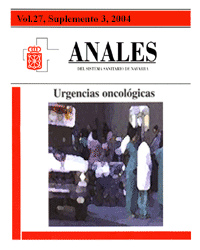Respiratory emergencies
Keywords:
Urgencias respiratorias. Obstrucción de la vía aérea. Hemoptisis. Patología pulmonar parenquimatosa.Abstract
Respiratory emergencies in a patient with cancer can have their origin in pathologies of the airway, of the pulmonary parenchyma or the large vessels. The cause can be the tumour itself or concomitant complications. Obstruction of the airway should be initially evaluated with endoscopic procedures. Surgery is rarely possible in serious situations. The endobronchial placement of stents or radioactive isotopes (brachytherapy), tumoural ablation by laser or photodynamic therapy can quickly alleviate the symptoms and re-establish the air flow. Treatment of haemoptysis depends on the cause that is provoking it and on its quantity. Bronchoscopy continues to be the front line procedure in the majority of cases; it provides diagnostic information and can interrupt bleeding through washes with ice-cold serum, endobronchial plugging or topical injections of adrenaline or thrombin. External radiotherapy continues to be an extraordinarily useful procedure in treating haemoptysis caused by tumours and in carefully selected situations of endobronchial therapy with laser or brachytherapy, and bronchial arterial embolisation can provide a great palliative effect. Respiratory emergencies due to pulmonary parenchyma disease in the oncology patient can have a tumoural, iatrogenic or infectious cause. Early recognition of each of these will determine the administration of a specific treatment and the possibilities of success.Downloads
Downloads
Published
How to Cite
Issue
Section
License
La revista Anales del Sistema Sanitario de Navarra es publicada por el Departamento de Salud del Gobierno de Navarra (España), quien conserva los derechos patrimoniales (copyright ) sobre el artículo publicado y favorece y permite la difusión del mismo bajo licencia Creative Commons Reconocimiento-CompartirIgual 4.0 Internacional (CC BY-SA 4.0). Esta licencia permite copiar, usar, difundir, transmitir y exponer públicamente el artículo, siempre que siempre que se cite la autoría y la publicación inicial en Anales del Sistema Sanitario de Navarra, y se distinga la existencia de esta licencia de uso.








